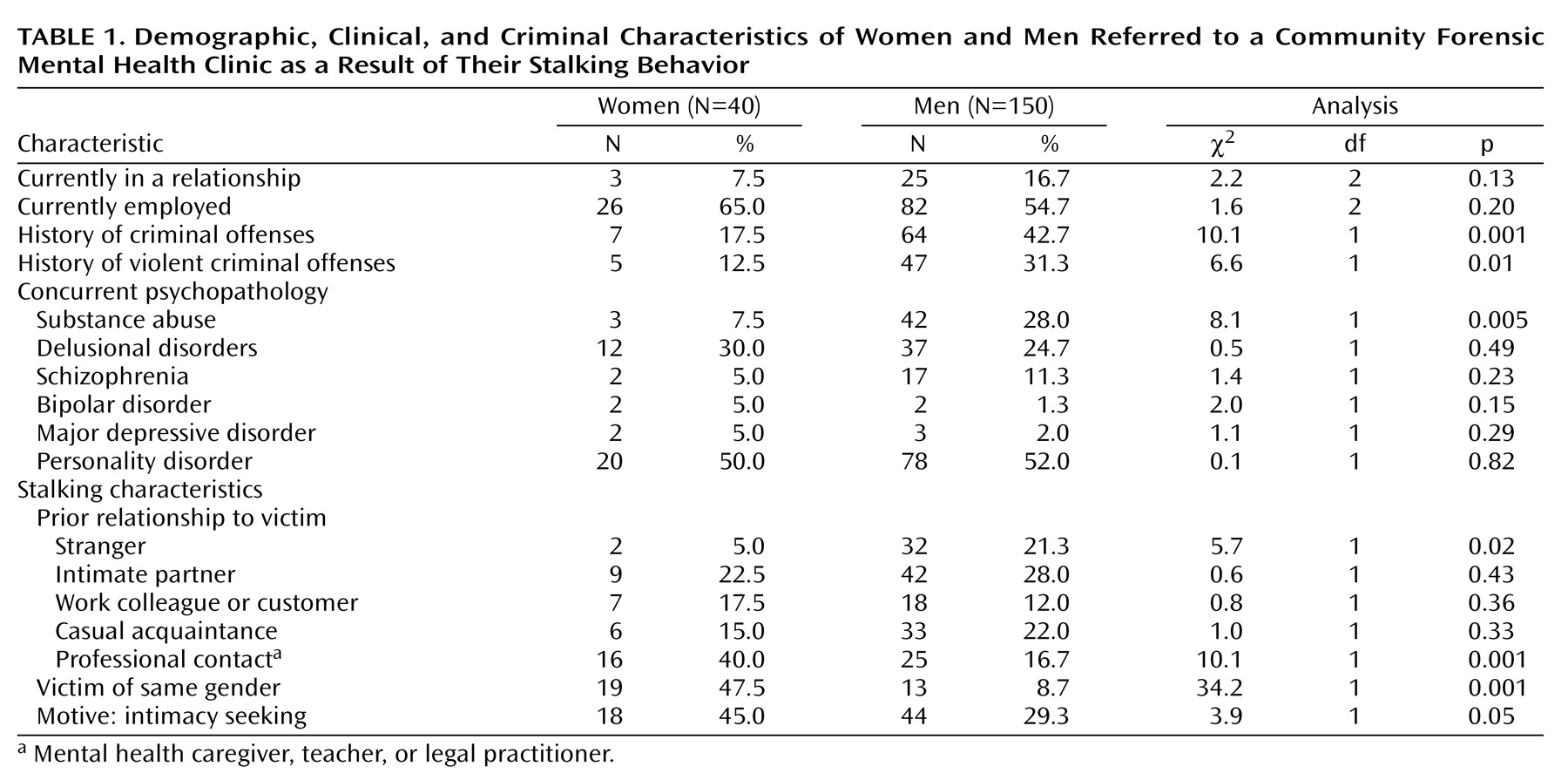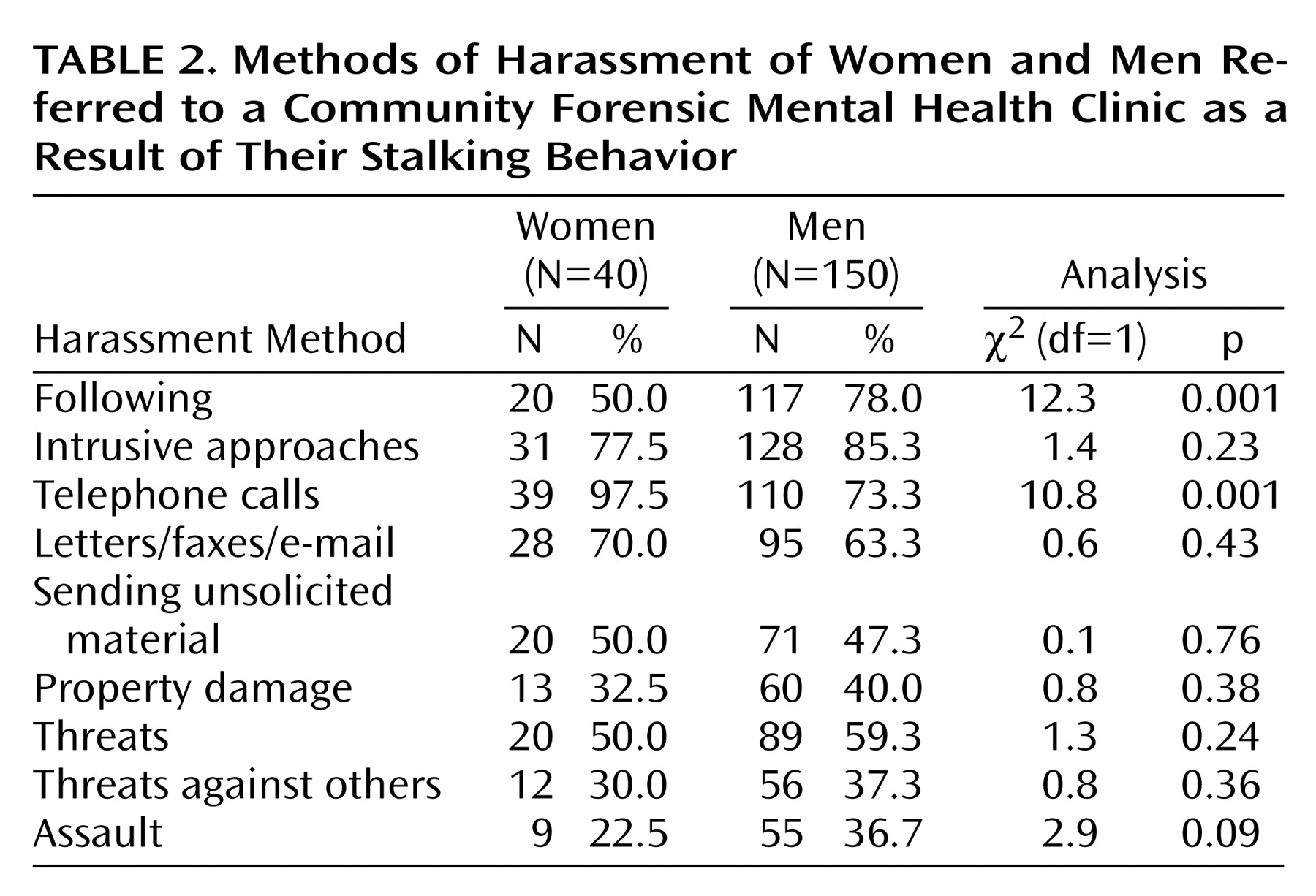The “modal” stalker has been described as a “male in his fourth decade of life pursuing a prior sexual intimate”
(1). Clinical and epidemiological studies confirm that the primary perpetrators of this crime are men and that the overwhelming majority of victims are women
(2–
6). Nonetheless, stalking is a gender-neutral behavior. However, outside the literature on erotomania
(7–
10), little attention has been given to women who persistently intrude on and stalk others.
Stalking by women is not uncommon. Community-based studies of stalking victimization indicate that women are identified as perpetrators in 12%–13% of cases
(4,
11). Studies conducted in forensic mental health settings have reported higher rates, often reflecting the greater incidence of erotomania in these populations. Zona et al.
(12) reported that 32% of subjects (N=24 of 74) investigated by a specialist antistalking unit were female, six of whom were classified as erotomanic. Harmon et al.
(13) similarly found that 33% of stalkers (N=16 of 48) referred to a forensic psychiatry clinic were female, although this rate dropped to 22% (N=38 of 175) in a subsequent and larger study
(14). Other studies have reported rates of between 17%
(1) and 22%
(15). In addition to first-hand victim accounts
(16,
17), further illustrative examples of female harassers abound in media reports on the stalking of celebrities (e.g., actor Brad Pitt, author Germaine Greer, and television host David Letterman).
Despite the frequency with which women engage in stalking, to our knowledge no study to date has considered the contexts in which this behavior emerges among women or whether female stalkers differ from their male counterparts in relation to stalking characteristics or propensity for violence. Greater awareness of and attention to this issue is indicated for several reasons. In our experience, those who find themselves the victim of a female stalker often confront indifference and skepticism from law enforcement and other helping agencies. Not infrequently, male victims allege that their complaints have been trivialized or dismissed, some victims being told that they should be “flattered” by all the attention. In the case of same-gender stalking by women, the sexual orientation of both the victim and the perpetrator is frequently questioned, with authorities often inappropriately assuming a homosexual motive
(18). Victimization studies indicate that women are seldom prosecuted for stalking offenses, with criminal justice intervention most likely to proceed in those cases involving a male suspect accused of stalking a woman
(3). The available evidence suggests that stalking by women has yet to be afforded the degree of seriousness attached to harassment perpetrated by men. This is despite any empirical evidence that women are any less intrusive or persistent in their stalking or pose any less of a threat (physical or otherwise) to their victims.
This study describes a group of female stalkers and compares them to a male stalker group to examine any differences in demographic characteristics; psychiatric status; motivation, methods, or duration of stalking; or rates of associated threats and assault.
Method
The case material was drawn from referrals over an 8-year period (1993–2000) to a community forensic mental health clinic that specializes in the assessment and management of both stalkers and stalking victims. The cases were assessed by one or more of the authors. Referrals came from throughout the Australian state of Victoria (population: 4.7 million), predominantly through courts, community correctional services, police, and medical practitioners. Collaborative information was available usually in the form of victim statements, police summaries of the offenses, official criminal records, and psychological or psychiatric reports. For the purposes of this study, we defined stalking as persistent (duration of at least 4 weeks) and repeated (10 or more) attempts to intrude on or communicate with a victim who perceived the behavior as unwelcome and fear-provoking
(5). This was an intentionally conservative definition to ensure that members of the study group were unequivocally stalkers. The psychiatric classification employed DSM-IV criteria.
A subgroup of female stalkers was identified and compared to their male counterparts in relation to demographic and stalking characteristics. The data analyses were conducted by using SPSS version 9.01 (SPSS, Chicago). Discrete variables were compared by using chi-square analyses, and continuous variables were compared by using Mann-Whitney U tests (two-tailed). The error rate required to demonstrate significance was set at 0.05.
Discussion
This study compared the demographic and pursuit characteristics of women and men referred to a community forensic mental health clinic as a result of their stalking behavior. Female stalkers did not differ from their male counterparts in terms of their demographic profiles or psychiatric status, although male stalkers were more likely to have histories of criminality and substance abuse. The intrusiveness and duration of stalking activities were equivalent between groups, as were the rates of associated threats and violence. What did distinguish female from male stalkers, however, was their choice of victim, the underlying motivation for their stalking, and the context in which their behavior emerged.
With only two exceptions, female stalkers in this study pursued an individual already known to them. A substantial proportion (40%) fixed their attention on those with whom they had professional contact, particularly psychiatrists, psychologists, and family physicians, although teachers and legal professionals were occasionally targeted. While the choice of victim among female stalkers was heavily skewed toward professional contacts, male stalkers pursued a broader range of victims, with similar proportions harassing prior intimate partners, acquaintances, strangers, and professionals. Stalking by men was also more strongly gendered, with 91% pursuing victims of the opposite sex, in contrast to women, who were equally likely to target men and women. Very few cases of same-gender stalking among women, however, involved homosexual motivations. Only two women in this series reported their sexual orientation as being homosexual; in both instances, their stalking was directed against prior sexual intimates. While it is often assumed that same-gender stalking cases involve homosexuality in either the perpetrator, the victim, or both, the data here suggest that this is the exception rather than the rule (see also reference
18).
Closely related to the choice of victims among female stalkers was the motivation for the stalking. For almost one-half, the stalking emerged from a desire to forge an intimate relationship with the victim. One-quarter of the female stalkers manifested erotomanic delusions, with the remainder hopeful that their pursuit would culminate in a relationship. The nature of the hoped-for intimacy, although usually romantic or sexual, also encompassed such aspirations as establishing a friendship or even a mothering alliance with the victim. Given the rates of serious mental illness among female stalkers in this sample (18 of 40 [45%] had major axis I psychiatric diagnoses), it is perhaps not surprising that mental health clinicians were so frequently targeted, their professional concern and empathy easily reconstructed as romantic interest.
While research has examined the risks of violence posed by patients against clinicians
(19–
21), few studies have considered the risks of stalking by current or former clients. Romans et al.
(22) reported that 6% (N=10 of 178) of the university counselors in their survey indicated having been stalked by a client, including five female perpetrators. Sandberg et al.
(23) identified 17 psychiatric inpatients (three who were female), who had stalked, harassed, or threatened hospital staff after discharge. Lion and Herschler
(24) described nine case studies involving clinicians who were stalked by clients, including seven psychiatrists, a psychologist, and one plastic surgeon who was fatally attacked by a female patient. Although small and selective, these studies point to the stalking of clinicians as a salient and potentially damaging behavior. In our experience, mental health practitioners who have been stalked by patients not infrequently confront judgmental rather than sympathetic responses from their colleagues, with accusations of incompetence in managing transference issues common in such cases. A handful of clinicians have ultimately abandoned their careers because of the experience of being stalked coupled with a lack of support from their peers. Greater recognition of the vulnerability of health professionals to stalking is warranted. At a minimum, clinical and administrative policies regarding inappropriate contact and harassment by clients should be developed and adhered to by workplaces, so that when such problems arise they can be acted on expeditiously and afford health professionals better protection.
Contrary to popular assumptions, this study found that female stalkers are no less likely than their male counterparts to threaten their victims or attack their person or property. Male stalkers were more likely, however, to progress from explicit threats to physical assaults on the victim. The methods of harassment were largely equivalent between the groups, the exceptions being telephone calls (favored by all but one female stalker) and following (preferred by male stalkers). The tenacity male and female stalkers apply to their quest is also strikingly similar. Thus, while the contexts for stalking vary between men and women, the intrusiveness of the conduct and its potential for harm does not. There is no reason to presume that the impact of being stalked by a female would be any less devastating than that of a man, although insufficient data precluded analysis of this issue here.
To our knowledge, this is the first study to compare female and male stalkers. Women undoubtedly are the predominant victims of the crime of stalking, but it is important to recognize that in a significant minority of stalking cases, women are the perpetrators. Female stalkers are typically socially isolated individuals with high rates of mental illness and characterological disturbance. Although driven in some instances by resentment or retaliation for perceived hurts, the majority are motivated by a desire to establish an intimate relationship with the victim, who often is a professional helper. Psychiatric interventions aimed at managing the underlying mental illness are crucial to the resolution of stalking behaviors in this group, but therapists providing such treatment should be cognizant of the vulnerability sometimes inherent in this role.



